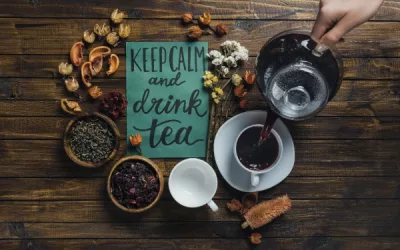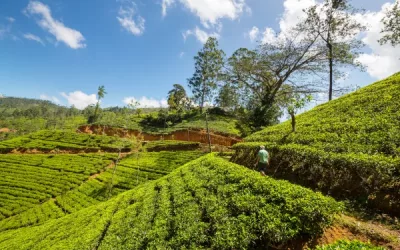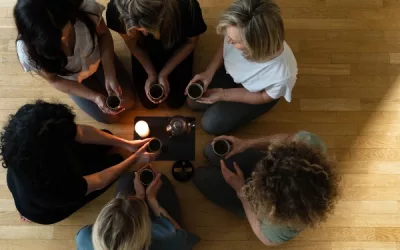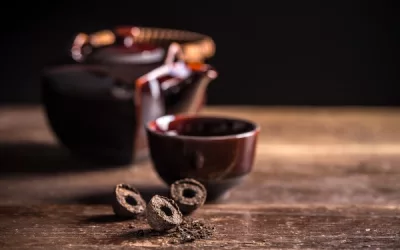Have you ever wondered why some teas have the power to captivate your senses while promising health benefits? Enter gunpowder tea, a unique green tea known for its distinctive rolled leaves and vibrant flavour. This article will take you on a journey through the rich history, meticulous production methods, and exceptional brewing techniques of gunpowder tea. Whether you’re a seasoned tea enthusiast or just curious, understanding gunpowder tea can enhance your appreciation of this cultural gem and its myriad health benefits. Let’s dive in!
Table of Content
What is gunpowder tea?
Gunpowder tea, known as “Zhū Chá” in Chinese, is a unique type of green tea that dates back to the Tang dynasty. It gets its name from its distinctive appearance, as each tea leaf is rolled into tiny, round pellets that resemble gunpowder grains. This tea is primarily produced in Zhejiang Province, China, and is known for both its robust flavour and storied cultural significance.
Gunpowder tea undergoes a meticulous production process. The leaves are withered, steamed, rolled, and then dried. Rolling the leaves into tight pellets helps to preserve their freshness and flavour during storage.
When brewed, these pellets unfurl, releasing a smoky yet slightly sweet flavour that many tea enthusiasts find intriguing. Beyond its unique taste, gunpowder tea offers several health benefits, including antioxidants and vitamins that can support overall wellness.
What are the main characteristics of gunpowder tea?
Gunpowder tea stands out due to several defining features. These characteristics make it a favourite among tea enthusiasts and those keen on exploring traditional Chinese teas.
- Appearance: Each leaf is tightly rolled into small, pellet-like shapes.
- Aroma: It has a smoky, earthy aroma with hints of sweetness.
- Flavour: The tea boasts a robust, slightly smoky flavour with subtle sweet undertones.
- Colour: When brewed, it produces a golden to dark green infusion.
- Longevity: The rolling process helps it stay fresh longer than other green teas.
These attributes make gunpowder tea easily recognisable and enjoyable for those seeking a distinctive tea experience.
How does the production process affect its flavour?
The flavour of gunpowder tea is deeply influenced by its production process. Each step contributes to the unique taste profile that many find appealing.
- Withering: Reduces moisture content, concentrating the flavours.
- Steaming: Prevents oxidation, preserving the green colour and fresh taste.
- Rolling: Enhances the tea’s longevity and deepens the flavour as the pellets unfurl during brewing.
- Drying: Locks in the flavours and creates the signature smoky note.
These steps ensure that gunpowder tea maintains its robust, smoky flavour, which is a result of careful craftsmanship and traditional methods.
What health benefits are associated with gunpowder tea?
Gunpowder tea is not only cherished for its unique taste but also for its numerous health benefits. Regular consumption can contribute to overall well-being.
- Antioxidants: Rich in catechins that combat free radicals.
- Vitamins: Contains vitamin C and other essential nutrients.
- Metabolism: May help boost metabolism and aid in weight management.
- Heart Health: Can improve cardiovascular health thanks to its anti-inflammatory properties.
- Energy: Provides a gentle caffeine boost without the jitters.
These health benefits make gunpowder tea a smart choice for those looking to enhance their diet with nutritious and delicious beverages.
In ancient China, gunpowder tea held great cultural significance. It was often used in traditional ceremonies and as a gift to honour guests. One notable historical story involves the Tang dynasty, during which tea culture flourished.
Emissaries from China gifted gunpowder tea to foreign dignitaries, showcasing China’s rich heritage and hospitality. This practice helped spread the appreciation of gunpowder tea far beyond its origins, embedding it in various cultures around the world.
How is gunpowder tea made?
Gunpowder tea is a type of green tea known for its unique production process and distinct pellet-like appearance. This tea gets its name because the rolled leaves resemble old-fashioned gunpowder grains. The intricate production process involves several steps, each contributing to the tea’s flavour and aroma. As a tea enthusiast, understanding this process can deepen your appreciation for this remarkable brew.
The production of gunpowder tea requires a detailed and methodical approach. Each step in the process plays a crucial role in shaping its flavour. Below, you’ll find a table that breaks down these steps, outlining the time required for each and their impact on the tea’s flavour.
Steps in the production process of gunpowder tea
To make it easier to follow, the table shows the main steps involved in producing gunpowder tea, the time each step takes, and how each step affects the flavour of the final product.
| Step Description | Time Required | Flavour Impact |
|---|---|---|
| Plucking | 1-2 days | Fresh and vibrant flavour |
| Withering | 12-24 hours | Reduces moisture, allowing for a smoother taste |
| Steaming | 30-60 seconds | Preserves the green colour and fresh, grassy notes |
| Rolling | 1-2 hours | Enhances the oxidation process, contributing to the tea’s robust and smoky taste |
| Drying | 2-3 hours | Finalises the leaf shape, locking in the flavour |
| Sorting | 1-2 hours | Ensures consistency in leaf size, contributing to even brewing and taste |
| Packaging | 1 hour | Protects the tea from moisture and light, maintaining its fresh taste |
The production of gunpowder tea involves several stages, each meticulously carried out to ensure the tea’s distinctive characteristics. Understanding these stages allows you to appreciate the complexity and craftsmanship behind each cup.
What are the health benefits of gunpowder tea?
Gunpowder tea offers numerous health benefits, thanks to its rich antioxidant content and other beneficial compounds. Drinking this tea can support your overall well-being in several ways.
- Rich in antioxidants, which help combat free radicals.
- Contains polyphenols that reduce inflammation.
- Boosts metabolism, aiding in weight management.
- Supports heart health by improving cholesterol levels.
- Enhances mental alertness due to its caffeine content.
Incorporating gunpowder tea into your daily routine can contribute to better health and vitality. Its unique combination of compounds promotes various aspects of your well-being, making it a valuable addition to your diet.
How do you brew gunpowder tea?
Brewing gunpowder tea properly ensures you get the best flavour and maximum benefits from each cup. Follow these steps to brew the perfect cup of gunpowder tea.
- Use fresh, filtered water for the best taste.
- Heat the water to around 80°C (176°F).
- Add one teaspoon of gunpowder tea per cup.
- Steep for 2-3 minutes, depending on your preference.
- Strain the tea and enjoy.
Brewing gunpowder tea is simple and straightforward, allowing you to enjoy its rich flavour and health benefits with minimal effort. By following these steps, you can ensure a delightful tea experience every time.
In the 9th century, Chinese merchants began trading with Arab traders, who introduced gunpowder tea to the Arabian Peninsula. The tea quickly gained popularity due to its unique properties and long shelf life.
Sailors appreciated its resilience during long voyages, making it a sought-after commodity in international trade. This historical exchange illustrates how gunpowder tea played a role in cultural and economic exchanges between China and the Arabian world.
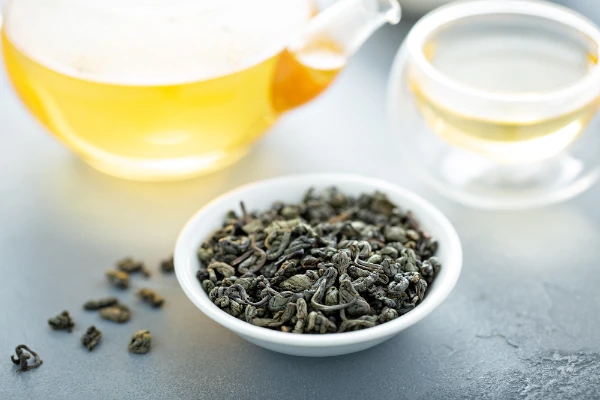
What does gunpowder tea taste like?
Fancy a tea that packs a punch? Then gunpowder tea is your new best friend. This little dynamo gets its name not because it explodes with flavour (though it kind of does) but because its leaves are rolled into tiny pellets that resemble gunpowder grains. Quite the rebel of the tea world, wouldn’t you say?
When brewed, gunpowder tea unveils a robust and slightly smoky flavour. Yup, this isn’t your shy, retiring chamomile. This tea stands tall with malty, earthy notes and a boldness that hits you right from the first sip. Perfect for people who like their tea a bit daring. But that’s not all—there’s also a hint of sweetness that softens its strong personality. The aroma? Think of a mix of roasted chestnuts and a walk through a pine forest after rain. Intrigued? You should be.
How would you describe the taste of gunpowder tea?
Imagine taking a stroll through a peaceful forest, where a light mist slowly fills the air with earthy scents. Now, shrink that forest into a tiny pellet and drop it into hot water. Voilà, you’ve got gunpowder tea in a cup!
- Earthy: It brings a grounding, earthy taste that one could even describe as malty. It’s kind of like if Mother Nature decided to throw a tea party.
- Slightly Smoky: There’s this wonderful, mild smoky flavour—like a whisper of a campfire—that adds a unique character.
- Sweet: Just when the earthiness has you thinking it’s all business, a subtle honey-like sweetness jumps in, balancing the flavour profile perfectly.
- Bold: This isn’t some dainty floral tea; oh no, it’s bold and robust, with a pronounced taste that lingers on your palate.
It’s the kind of tea that makes you sit up and take notice. And hey, if you’re into taking tea with a side of character, this is your brew.
What aromas can be detected when brewing?
Stick your nose into a freshly brewed cup of gunpowder tea, and you’ll get an aromatic experience that’s like a sensory rollercoaster.
- Roasted Chestnuts: Expect an aroma reminiscent of roasted chestnuts—warm, nutty, and oh-so-inviting.
- Pine: There’s a subtle pine scent, putting you in mind of fresh woods after a drizzle.
- Hay: Yes, hay. It gives a fresh, somewhat grassy aroma that’s utterly charming in its simplicity.
- Charcoal: A whisper of charcoal, like the last glowing embers of a campfire, adds a smoky undertone.
Together, these aromas form a complex and satisfying bouquet that makes you want to dive right in. It’s like a comforting, aromatic hug for your senses.
How does it compare to other green teas?
Alright, how does it stack up against your run-of-the-mill green teas? Good question, sharp thinker. Let’s break it down.
- Processing: Typical green teas are often more delicate in their processing—gently hand-rolled and dried. Gunpowder tea? It’s rolled into tight pellets, which gives it its unique taste.
- Flavour: While most green teas are light, floral, and somewhat grassy, gunpowder tea brings a bolder, more robust flavour with smoky, earthy tones.
- Longevity: This is the Energizer Bunny of teas—the leaves can be re-brewed multiple times and still retain flavour. Most green teas? One and done, baby.
- Mouthfeel: Gunpowder tea has a fuller mouthfeel. It’s not just thin and watery; it feels richer, almost velvety, coating your mouth with its complex flavours.
In essence, if green teas were a family, gunpowder tea would be the adventurous cousin who’s always off on some daring escapade. Fun at parties and always bringing something new to the table.
Let’s end with an interesting tidbit. Back in the Tang Dynasty, gunpowder tea gained popularity not just within China but also on the Silk Road. Traders carried it across harsh deserts, treating it like rare treasure.
The fact that these tightly rolled pellets could endure long journeys without losing flavour made them a hit. So, every time you brew a cup, you’re kind of participating in a centuries-old tradition. Not bad for a cup of tea, right?
How do you brew gunpowder tea?
When it comes to brewing gunpowder tea, it’s all about precision, patience, and a bit of flair. This tea, known for its tightly rolled leaves resembling pellets, requires just the right touch to coax out its full flavour. It’s not rocket science, but it never hurts to have a guide.
So let’s get down to brass tacks: the ideal water temperature, the perfect steeping time, and the golden tea-to-water ratio. Stick to these and you’ll be sipping your way to tea nirvana.
First off, if you want to get the best out of your tea, start with fresh, filtered water. Tap water? Only if you like chlorine with your tea. And for goodness’ sake, warm the teapot beforehand – trust me, it makes a difference. Now, heat that lovely water to just the right temperature, and you’re well on your way to tea heaven.
What is the ideal water temperature for brewing?
If you think you can just boil water and dump it over your tea leaves, think again. The ideal temperature for brewing gunpowder tea is a bit of a Goldilocks situation – not too hot, not too cold.
- Aim for 70-80°C (160-175°F). Any hotter, and you’ll scorch those delicate leaves, making your tea bitter – not ideal.
- Too cold, and you won’t extract the full flavour, leaving you with a sad, lacklustre brew.
- Use a thermometer if you want to be precise – yes, it’s that important.
- No thermometer? No problem. Just let the boiling water cool down for about 2-3 minutes and you should be good to go.
This mid-range hotness is where gunpowder tea leaves really come alive, releasing all their nuanced flavours without turning bitter or flat.
How long should you steep gunpowder tea?
Now, about steeping time – it’s a bit of a balancing act. Too long and you’ll end up with something that tastes like you’ve left your socks in the wash too long; too short, and you might as well be drinking hot water.
- Steep your tea for about 2-3 minutes. Any longer and your tea might start tasting like grandma’s medicine cabinet.
- If you’re a bit of a rebel and like stronger tea, try 4 minutes, but that’s pushing it.
- For the first steep, aim for 2 minutes to gauge the strength. You can always go stronger on the next round.
- Strain or remove the tea leaves immediately once done steeping. An over-steeped gunpowder tea is not a happy tea.
Remember, tea is like a fine wine – let it breathe and develop, but don’t overdo it. You want those rolled leaves to unfurl just right, releasing their full potential.
What is the recommended tea-to-water ratio?
Let’s talk numbers. When it comes to the tea-to-water ratio, getting it right means the difference between a cup of flavourful decadence and something that tastes like diluted sadness.
- The magic formula: 1 teaspoon of gunpowder tea per 150-200ml of water.
- For a stronger brew, you can add a bit more tea – but don’t go overboard.
- If you’re making a pot, scale up accordingly. A standard-sized teapot usually holds about 750ml, so adjust your measurements to roughly 1-1.5 tablespoons.
- Use a tea infuser or a strainer to make clean-up easier and ensure you get the perfect pour.
Measuring your tea might seem a bit like having a fancy coffee scale, but trust me, once you find your perfect ratio, you’ll never look back.
Let’s dive into a bit of historical flavour to top this off. In the mid-19th century, British tea zealots, searching for the next big thing, stumbled upon gunpowder tea in China’s Zhejiang Province. Intrigued by its unique pellet-like appearance and robust flavour, they began importing it in droves.
One such enthusiast was Charles Grey, the second Earl and Prime Minister, of course, known for the famous Earl Grey tea. A fervent fan of exotic blends, Grey played a pivotal role in popularising various teas, including our beloved gunpowder tea, adding a touch of the exotic East to British tea culture. Cheers to that!
What cultural significance does gunpowder tea hold?
If you’re a tea enthusiast or someone who just can’t get enough of the mystical tales from Chinese culture, then fasten your seatbelt. We’re diving into the fascinating world of gunpowder tea— the tea that, no, does not explode, but rather, rolls into your life with historical significance, cultural relevance, and a flavour punch that leaves you wanting more.
Historically, this tea has roots deep in Chinese soil, going back to the Tang dynasty (618–907 AD). Its unique production—rolling leaves into tiny pellet forms—was a preservation technique during ancient times, allowing for easier storage and transportation. This clever method paid off, as gunpowder tea became a hot commodity, quite literally and figuratively, in international trade.
How was gunpowder tea historically used in trade?
Picture this: ancient merchants laden with tea chests, trudging along the Silk Road, trading these rolled leaves of joy for spices, silk, and gold.
- Trade Routes: Gunpowder tea was a prime player on the Silk Road, connecting China to the Middle East, Africa, and Europe.
- Preservation: Its tightly rolled leaves kept it fresh for longer journeys.
- Barter Power: This tea was more than a beverage; it was a form of currency and a valuable trade item.
- European Entry: It landed in Europe in the 17th century, gaining popularity at breakneck speed.
- Colonial Times: It even hit the American colonies, contributing to the tea culture that eventually led to the infamous Boston Tea Party.
You might wonder, why all the fuss about this particular tea? Well, its durability and unique taste made it a favoured option during long voyages and one that traded like hotcakes, if hotcakes were, you know, tea.
What role does it play in modern Chinese culture?
Fast forward to 2023, and gunpowder tea remains an integral part of Chinese culture, though the narrative has evolved considerably.
- Tea Ceremonies: It is still a staple in traditional Chinese tea ceremonies, vital for fostering social bonds.
- Symbolism: Representing durability and strength, it’s more than a drink—it’s a statement.
- Culinary Use: In Chinese cuisine, it’s not just for sipping but also used in cooking to infuse dishes with its unique aroma.
- Everyday Life: In many Chinese households, it serves as a daily beverage, offering a taste of tradition in every cup.
- Health Benefits: Modern science has backed its health perks, such as high antioxidants, adding to its current appeal.
In essence, gunpowder tea has gracefully adapted to modern times, but its roots in ancient customs and traditions remain ever-strong.
Why is it considered a cultural symbol?
Now, let’s get symbolic. If you’re thinking about what makes a tea the poster child for an entire culture, gunpowder tea has the credentials.
- Heritage: It embodies centuries of Chinese tea-making and drinking traditions.
- Resilience: Its durable form showcases the resourcefulness and adaptability of Chinese culture.
- Social Glue: Facilitates gatherings and is an excuse to commune, akin to sharing stories around a proverbial campfire.
- National Pride: Representing something intrinsically Chinese on a global scale.
- Health Emphasis: The focus on its health benefits mirrors traditional Chinese medicine’s long-standing focus on using natural remedies.
As you can see, gunpowder tea is much more than just tightly rolled leaves. It’s an emblem of resilience, heritage, and social connectivity.
In ancient China, an emperor named Qianlong from the Qing Dynasty was so enamoured with tea that he made several journeys down south to sample the best brews. One story goes that while visiting the Fujian province, he came across a village where the locals served him gunpowder tea, brewed to perfection.
So impressed was Qianlong by its taste and resilience during travel, he immediately decreed it as one of his preferred teas, ensuring its place in the annals of Chinese tea culture forever. So, next time you sip this ancient brew, remember you’re partaking in a tradition that once thrilled emperors and fuelled global trade.
What are some common misconceptions about gunpowder tea?
Gunpowder tea, with its catchy name and mysterious origins, is often surrounded by a cloud of myths. This is the tea equivalent of an urban legend, from misunderstandings about caffeine content to misguided flavour expectations and exaggerated health claims. Let’s dismantle these myths one by one and get to the bottom of the misconceptions.
First off, when you hear the name “gunpowder tea,” you might picture something explosive. Relax, it won’t blow your socks off—at least not literally. The name comes from the tea leaves being hand-rolled into tiny pellets that resemble—you guessed it—gunpowder. This traditional Chinese tea is as straightforward as its rolling process.
What are common myths about its caffeine content?
Ready for myth number one? Many people think it’s loaded with caffeine!
- Explosively caffeinated: People believe gunpowder tea has caffeine levels similar to fireworks, but it’s no more caffeinated than your average green tea.
- Energy booster extraordinaire: Expecting it to rocket you to the moon energy-wise? Sorry, but it can’t compete with a double espresso.
- Better than coffee: Comparing its caffeine kick to coffee is like comparing a firecracker to dynamite.
- All teas are created equal: False! Caffeine content can vary, but gunpowder tea doesn’t stand out.
- Consistent kick: Your cuppa can have variable caffeine, depending on the leaf quality and quantity.
The reality is, the caffeine content in gunpowder tea is pretty moderate. Accept it as a gentle wake-up call, not a siren blaring through the morning fog.
How do expectations of flavour differ from reality?
Misconception number two: Its flavour will knock your taste buds around.
- Bitter bomb: People think it’ll be overwhelmingly bitter, but it’s actually quite balanced.
- Strong-as-steel taste: Some expect a flavour as intense as its name, yet it mellows out wonderfully.
- Uni-flavour tea: Gunpowder tea boasts a spectrum of subtleties, not just a single note.
- Smoky sensation: While the roasted flavour is there, it’s not like you’re drinking liquid ash.
- One-dimensional: The palate reveals layers of complexity when brewed properly.
Many folks expect a flavour comparable to licking a charred piece of wood but are pleasantly surprised by its delicate, subtle taste. Brew it right and you’ll uncover a pleasant mix of smooth, slightly smoky and fresh floral notes.
What health claims are often exaggerated?
And now, onto our final myth: It cures everything but a rainy day.
- Miracle tea: No, it won’t grant you immortality or eternally clear skin.
- Weight loss wonder: While it can aid digestion, it’s no substitute for a balanced diet and exercise.
- Ultimate detox: It’s healthy, sure, but it won’t purify you like a high-end water filter.
- Heart hero: Beneficial, yes, but don’t ditch your prescribed medication.
- Full immunity shield: Great for the immune system, but it’s not a standalone cure.
Sure, gunpowder tea brings excellent health benefits, such as antioxidants and aiding digestion, but don’t expect it to transform you into a superhuman.
Speaking of tea myths and legends, did you know that the famous tea trade route, the Silk Road, was as captivating as the beverages exchanged along it? Imagine the ancient traders lugging bags of tea leaves, including our humble gunpowder tea, across mountains and deserts to reach eager consumers in faraway lands.
These traders were the unsung heroes who helped bring tea—and its benefits—to the masses. So next time you sip your gunpowder tea, remember, it’s part of a legacy that once spanned continents and changed the world, one soothing cup at a time.
Conclusion
In summing up our exploration of gunpowder tea, it becomes clear that this unique beverage is much more than just a tasty drink; it’s a rich tapestry woven from history, culture, and health wisdom.
We’ve delved into its distinctive characteristics, from its somewhat robust flavour profile—marked by its smoky notes and green tea essence—to its painstaking production process, which meticulously shapes its final taste.
The health benefits associated with gunpowder tea, including its rich antioxidants and potential aid in weight loss, add another compelling layer to this esteemed beverage.
Understanding these aspects underscores the importance of gunpowder tea not only in individual wellness but also as a cultural symbol deeply rooted in Chinese tradition. It has flourished through centuries, serving both as an item of trade and a cherished element of modern Chinese culinary practices, highlighting its enduring appeal across generations.
As you consider your next cup of gunpowder tea, I encourage you to explore the myriad of brewing techniques we discussed. Experimenting with water temperature and steeping times might lead you to discover your perfect brew. And, of course, being mindful of where you source this unique tea can ensure you enjoy its authentic flavour and benefits.
I’m left reflecting on the role gunpowder tea plays in evoking a sense of cultural connectedness and health-centric consciousness. After all, in today’s fast-paced world, sharing a moment of tranquility over a cup of this remarkable tea can remind us of the leisurely rituals that many of us are missing.
As the historical proverb suggests, “Tea is the magic that brings us together,” and with gunpowder tea, that magic is palpable. So, the next time you sip this refined beverage, consider not just its rich flavour, but the centuries of tradition and culture that each leaf embodies.
Resources
- Can green tea preparations help with weight loss? – PMC
- Green tea for weight loss and weight maintenance in overweight … – PubMed
- The effects of green tea on weight loss and weight maintenance … – PubMed
- Catechin Composition, Phenolic Content, and Antioxidant … – Springer
- Catechin Composition, Phenolic Content, and Antioxidant … – ResearchGate
- Green tea extract: Chemistry, antioxidant properties and food … – ScienceDirect




